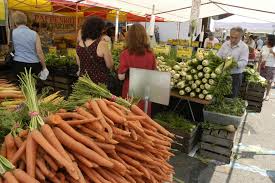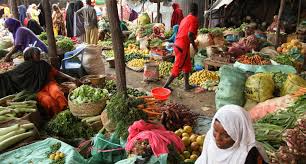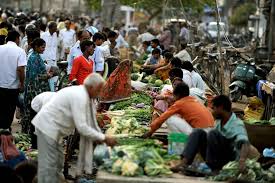Agricultural marketing plays a crucial role in agricultural performance, just as farming itself. For this reason, market reforms must be integrated into any agricultural development policy. Considerable progress has been made in technological advancements in agriculture through the use of high-yielding varieties and chemical fertilizers.
However, agricultural marketing was not fully recognized as an essential element in agricultural development in Nigeria until recently. It continues to hold a relatively low position in developing countries’ agricultural systems.
Read Also: Recommended Feed Formula for Piglets (Baby Pigs)
Concept and Definition of Agricultural Marketing

Agricultural marketing involves the marketing of farm products produced by farmers and the farm inputs needed for production. It includes functions such as product marketing and input marketing.
Agricultural marketing covers various aspects, including marketing functions, agencies, channels, efficiency, costs, price spread, market integration, producer surplus, government policy, research, training, and statistics. The term agricultural marketing comprises two elements: agriculture and marketing.
Agriculture refers to activities aimed at utilizing natural resources for human welfare, primarily through production. Marketing involves activities related to moving goods from the production point to the consumption point, including the creation of time, place, form, and possession utility.
Form utility is added to commodities through processing, time utility through storage, place utility through transportation, and possession utility through buying and selling within marketing channels.
Objectives of Agricultural Marketing
The objectives of agricultural marketing can be examined from the perspectives of producers, consumers, traders, and the government.
1. Farmers’ Interest: Farmers seek a marketing system that quickly purchases their produce and ensures they receive the highest share of the consumer’s payment. They aim to purchase inputs at lower costs while selling their products at higher prices.
2. Consumers’ Interest: Consumers look for a marketing system that supplies food and other items in the required quantity and quality at the lowest possible price.
3. Traders’ Interest: Traders favor a marketing system that provides them with a stable and growing income from purchasing and selling agricultural commodities. They benefit from buying produce at lower prices from farmers and selling it at higher prices.
4. Government’s Role: The government serves as a guardian of all the groups involved in marketing, ensuring the welfare of farmers, consumers, and traders alike.
Agricultural marketing encompasses the marketing of farm products as well as the inputs and services required for their production. As marketable surpluses of crops and other agricultural products increase, the focus shifts towards output marketing, enhancing the market orientation of farming.
Historically, farmers relied on local seeds and traditional farmyard measures for production inputs. Today, the use of improved seeds, fertilizers, insecticides, machinery, and credit is essential for farm production. Modern agricultural technology is input-dependent, which means agricultural marketing must account for both product and input marketing.
Importance of Agricultural Marketing

Agricultural marketing is vital for stimulating production, consumption, and economic development. Technological advancements have led to significant increases in production and consumption. To sustain these gains, an efficient marketing system is necessary to ensure farmers receive fair prices for their products.
Key Contributions of Agricultural Marketing to Economic Development
1. Optimizing resource use and output management: An efficient marketing system reduces losses during processing, storage, and transportation, which in turn increases the marketable surplus. A well-organized marketing system also ensures the effective distribution of modern inputs, fostering faster agricultural growth.
2. Increasing farm income: An efficient marketing system provides higher income for farmers by reducing the number of intermediaries and curbing marketing service commissions. This system enables farmers to get better prices for their products, encouraging them to invest in modern inputs to further increase production.
3. Expanding markets: A well-established marketing system extends the market reach of agricultural products, taking them to distant areas. This continuous expansion helps increase demand and ensures higher income for producers.
4. Supporting agro-based industries: An improved marketing system aids in the growth of agro-based industries and contributes to overall economic development.
5. Sending price signals: An efficient marketing system provides price signals, helping farmers plan their production based on the needs of the economy.
6. Promoting new technology: The marketing system plays a key role in the adoption and spread of new scientific and technological practices among farmers.
7. Employment generation: The marketing system provides employment opportunities to millions in activities such as packaging, transportation, and processing. Roles such as commission agents, brokers, retailers, weighmen, and support staff are part of this system.
8. Utility creation: While marketing adds costs to products, it also creates various utilities:
i. Form utility: Processing adds form utility by converting raw materials into more useful finished products (e.g., oil seeds into oil, cotton into cloth).
ii. Place utility: Transportation adds place utility by moving products from areas of surplus to areas of need.
iii. Time utility: Storage adds time utility by making products available when they are most needed.
iv. Possession utility: Buying and selling within the marketing system allow for the transfer of ownership from one individual to another.
Problems of Agricultural Marketing

The rapid development in agricultural research and the introduction of technological innovations, such as high-yielding varieties, improved agricultural implements, fertilizers, and pesticides in recent times, have brought about a breakthrough in agriculture.
This breakthrough, popularly known as the Green, White, Yellow, and Blue revolutions, has given rise to new problems in agricultural marketing. It is essential to maintain the momentum of these revolutions.
Farmers should be assured of fair prices for their produce; otherwise, they may lose the incentive to increase agricultural production. There is an urgent need in the current context to tackle the emerging problems of agricultural marketing more resolutely and efficiently than ever before. The important problems that have emerged in recent times pertain to the following areas:
1. Increase in Production Levels and Market Arrivals
With increased market arrivals, it is necessary that a large number of market yards be developed in rural areas with all the necessary marketing facilities. Without spacious market yards, it is not possible to centralize and effectively supervise the transactions taking place in the area.
The development of spacious market yards is also essential for performing various marketing functions, such as grading, cleaning, sieving, and weighing agricultural produce.
Presently, most markets do not have spacious market yards, and transactions are carried out in congested areas in the center of the city. Recently, some market committees have constructed spacious market yards, but the majority of market committees do not have them because of a lack of funds and the non-availability of land.
2. Price Instability
Agricultural prices are highly unstable and fluctuate violently. These prices fall in the post-harvest months and increase later in the year. The increasing instability in agricultural prices adversely affects the income of farmers as well as the drive to increase production.
There is, therefore, a need to reduce price instability. Several steps may be taken for farmers to get a better share of consumer money. Some of these steps include the fixation of minimum support prices for crops by the government, the purchase of commodities if the market price falls below that level, and the development of warehousing facilities to prevent post-harvest sales by farmers.
3. Market Intelligence
Market intelligence is another problem that has emerged and is an important part of orderly marketing. With increased market surplus and the opening up of trade, the importance of marketing intelligence has grown.
Farmers often sell their produce in the village and nearby assembly markets out of ignorance of the prices prevailing in nearby primary wholesale, secondary wholesale, and terminal markets. Traders take advantage of the farmer’s ignorance because they have full knowledge of prices in the market.
Read Also: 9 Ways to Fatten Up your Pigs the Right Way
4. Marketing of Agricultural Inputs

The marketing procedure for agricultural inputs needs improvement. This is especially important in the current context of using new technology. The newly evolved high-yielding variety (HYV) seeds are more responsive to other inputs, and arrangements for their timely availability are essential for the success of agricultural development programs.
5. Ancillary Facilities in the Market
Existing markets lack ancillary facilities such as banks, post offices, telegraph offices, and shopping centers. In addition, facilities for sorting, grading, and packing are not available in villages or primary markets. These facilities should be increased to provide full benefits to farmers.
6. Finance for Market Development
Market development with all the necessary ancillary facilities is highly capital-intensive, and the returns on investment in such development accrue slowly over several years. Therefore, special arrangements for financing market development are necessary.
7. Education of Farmers
It is equally necessary to educate farmers about the marketing of their agricultural produce so they can derive the full benefits of their activities. Without proper education, the benefits of agricultural advancements cannot reach farmers. This is especially true in the current context, where increased market surplus is available to producer-farmers.
8. Superfluous Middlemen
Since farmers sell a substantial portion of their produce in the village and nearby markets, a number of middlemen intervene between them and the consumer. As a result, the share of the consumer’s price that reaches the producer is reduced.
9. Inadequate Storage and Transportation Facilities
There is a general lack of good storage facilities in both rural and urban areas. The indigenous methods of storage used in villages do not adequately protect the produce, and physical loss increases as the storage period lengthens.
With the rise in production and marketable surplus, farmers and traders face challenges related to the availability of adequate and quick transportation at the village level, between markets, and across state borders.
10. Bulkiness and Perishability of Produce
Compared to other products, agricultural products are bulkier. Bulkiness affects marketing functions, particularly those related to physical handling. Products that occupy a lot of space relative to their value automatically increase unit transportation and storage costs.
Agricultural products are also more perishable than many other goods. These perishable products require speedy handling and often need special refrigeration, which increases marketing costs.
In conclusion, addressing these problems is essential to ensure effective agricultural marketing, support farmers’ income, and promote agricultural production.
Do you have any questions, suggestions, or contributions? If so, please feel free to use the comment box below to share your thoughts. We also encourage you to kindly share this information with others who might benefit from it. Since we can’t reach everyone at once, we truly appreciate your help in spreading the word. Thank you so much for your support and for sharing!
Read Also: The Benefits of Government Waste Recycling Programs

